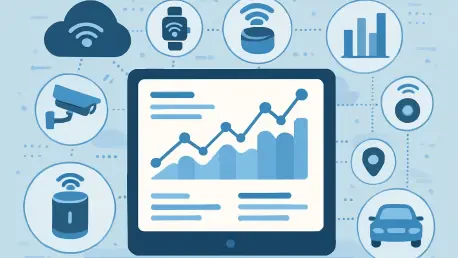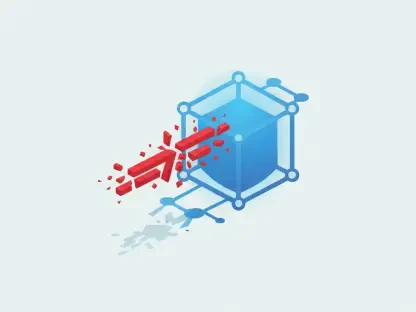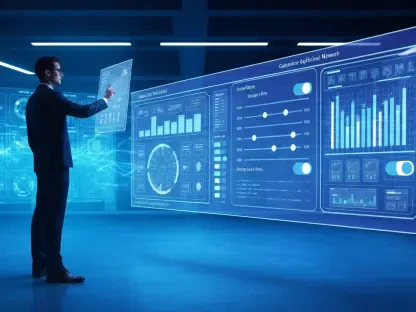Imagine a world where every connected device—from factory sensors to smart city traffic cameras—generates a constant stream of data that instantly transforms into actionable business strategies. In 2025, this is no longer a vision but a reality, as the IoT analytics market surges to new heights, fueled by artificial intelligence (AI) and edge computing. With billions of devices contributing to an estimated data volume of several zettabytes annually, the ability to process and analyze this information in real time has become a critical competitive edge. This market analysis explores the forces propelling IoT analytics forward, delving into key trends, major players, and future projections. The purpose is to equip stakeholders with insights into how these technologies are reshaping industries like manufacturing, healthcare, and logistics, while highlighting the strategic importance of staying ahead in a rapidly evolving digital landscape.
Diving Deep into Market Dynamics and Trends
Surge in AI Integration Fuels Analytical Precision
The IoT analytics market is witnessing a profound shift as AI becomes the backbone of data processing for connected ecosystems. Machine learning algorithms are now embedded in platforms to detect patterns, predict failures, and automate decisions across vast datasets. Companies leading this charge, such as C3 AI and IBM with its Watson IoT platform, have demonstrated significant impact in sectors like manufacturing, where predictive maintenance can slash downtime by substantial margins. Industry reports suggest that AI-driven solutions are enhancing operational efficiency by identifying anomalies in real time, though challenges remain in securing high-quality data for training models. As adoption accelerates, the market is expected to see AI integration deepen, with custom models becoming a standard for tailored insights over the next few years.
Edge Computing Redefines Speed and Cost Efficiency
Another transformative force is the rise of edge computing, which addresses the limitations of traditional cloud systems by processing data closer to its source. This trend is critical for time-sensitive applications, such as industrial automation and logistics tracking, where latency can disrupt operations. Firms like Microsoft, through Azure IoT Edge, and Yalantis are pioneering solutions that reduce data transfer costs by a notable percentage compared to cloud-only approaches, according to recent studies. While edge computing enhances speed and security, it introduces complexities in device management and vulnerability risks. Market projections indicate a growing preference for hybrid edge-cloud architectures, balancing immediacy with scalability, with adoption rates expected to climb sharply by 2027.
Sector-Specific Solutions Shape Competitive Landscapes
Customization for specific industries is emerging as a defining factor in the IoT analytics market. Platforms are no longer one-size-fits-all; instead, they are meticulously designed to address unique challenges in sectors like healthcare, energy, and smart cities. For instance, GE Digital’s Predix optimizes energy efficiency, while SAS focuses on complex diagnostics for medical applications. Regional variations also play a role, with European companies like Siemens aligning with stringent data privacy laws, contrasting with the scalability focus of U.S.-based AWS. Analysts note that cultural and regulatory readiness often influences deployment success, underscoring the need for bespoke strategies over generic tools. This trend toward specialization is anticipated to drive market segmentation further, creating niche opportunities for innovative providers.
Emerging Technologies and Regulatory Shifts
Looking at broader market influences, the convergence of IoT with 5G networks is set to revolutionize data processing capabilities by slashing latency to unprecedented levels. This advancement will enable applications previously constrained by speed, such as autonomous vehicles and real-time urban monitoring. Simultaneously, economic factors are pushing firms toward cost-effective serverless cloud models, with AWS IoT Analytics leading in this space. Regulatory changes around data privacy are also reshaping strategies, particularly in regions with strict compliance mandates. Forecasts suggest that by the end of this decade, a majority of IoT data will be processed at the edge, reflecting a fundamental shift in infrastructure priorities and investment focus within the market.
Unpacking Market Data and Future Projections
Current Market Size and Growth Trajectories
In 2025, the IoT analytics market is experiencing robust growth, driven by the escalating number of connected devices and the demand for real-time insights. Recent industry assessments estimate the market value in the billions, with a compound annual growth rate projected to remain strong through 2027. Key contributors to this expansion include widespread adoption in industrial IoT, where analytics optimize asset performance, and in smart cities, where data informs urban planning. The competitive landscape is crowded with innovators like PTC and Hitachi Vantara, each carving out dominance in specific verticals. This growth trajectory signals a maturing market, yet one with ample room for disruption as new entrants challenge established norms.
Investment Patterns and Technological Innovation
Investment in IoT analytics is pouring in, with significant capital directed toward AI and edge computing capabilities. Venture funding and corporate R&D budgets are prioritizing platforms that offer seamless integration with existing systems, as seen with solutions from Microsoft and IBM. Technological innovation remains a key differentiator, with firms like Yalantis gaining traction for their full-stack, customized approaches in logistics and healthcare. Market analysis indicates that over the next few years, investments will increasingly target hybrid models that combine edge immediacy with cloud depth. This pattern reflects a strategic focus on resilience, ensuring systems can handle both current demands and future scalability needs.
Challenges and Opportunities on the Horizon
Despite the optimistic outlook, the market faces hurdles that could temper growth if unaddressed. Data security at the edge remains a pressing concern, as distributed systems expand attack surfaces for cyber threats. Additionally, the complexity of integrating analytics with legacy infrastructure poses barriers, particularly for traditional industries. However, these challenges present opportunities for differentiation—firms that innovate in cybersecurity and interoperability are likely to capture significant market share. Projections also highlight the potential for smaller, agile players to disrupt the space by offering niche, industry-specific tools, challenging the dominance of larger corporations over the coming years.
Reflecting on Insights and Strategic Pathways
Looking back, the analysis of the IoT analytics market reveals a dynamic ecosystem where AI and edge computing redefine how industries leverage connected data. The deep integration of machine learning, the shift to edge processing, and the emphasis on tailored solutions stand out as pivotal trends that shape market evolution. For businesses navigating this landscape, the implications are profound, offering both competitive advantages and operational efficiencies. Moving forward, stakeholders are advised to prioritize partnerships with providers like Yalantis or Microsoft, whose expertise in hybrid architectures and sector-specific analytics proves invaluable. A strategic focus on pilot projects to test platforms, coupled with investments in workforce skills for AI and data integration, emerges as actionable steps to maintain relevance. Ultimately, the journey underscores that embracing IoT analytics is not just an option but a necessity for those aiming to transform raw data into a lasting asset.









